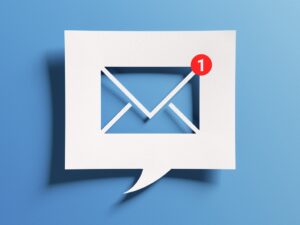Mindful messaging: Why you should stop hitting ‘reply all’ to emails
Deloitte’s chief well-being officer offers tips for sending internal emails with intention.

There are several ways to foster stronger employee communications across your organization, from holding town halls to hosting virtual happy hours and launching employee resource groups.
While that’s all well and good, many communicators skip over the part where they work with managers to articulate how employees can best communicate with each other across internal channels. In a time of remote and hybrid work, establishing these ground rules is critical. And, in a time when your workforce receives more emails than ever, creating the conditions for mindful email etiquette can be a foundational way to promote employee well-being.
That’s why Jen Fisher, chief well-being officer at Deloitte and co-author of “Work Better Together: How to Cultivate Strong Relationships to Maximize Well-Being and Boost Bottom Lines,” is on a mission to eliminate the reply-all email from inboxes across all digital workplaces.
Fisher spoke to Ragan about what it means to email with intention and offered some tips for being mindful with your internal email strategy.
Ragan: You’re on something of a self-described campaign to eliminate the “reply all” email from workplace behavior. Why is that?

Jen Fisher, chief well-being officer, Deloitte
Fisher: As humans, we’re very quick to adopt technology but slow to adapt to it. We need to be deliberate about how we use technology so that it supports, instead of impairs, our well-being. The key to doing this is to be intentional in how we use it. Using reply all has become a mindless tech habit that negatively impacts our own well-being and the well-being of others by clogging our inboxes, which causes unnecessary stress and distraction.
Ragan: Assuming people who aren’t needed on a reply are left out, what workflow best practices can we follow to make sure relevant information reaches everyone it needs to?
Fisher: It’s important to remember that email is not a great collaboration tool. If there is a lot of information that you are disseminating and if you are collecting input, using a collaborative platform designed for this purpose would be better suited than sending an email. Part of being intentional when it comes to email is to consider if email is even the right tool to use for your purpose.
Ragan: Some lean into the reply all because it lays out a single chronological thread for a project or relationship and keeps communications streamlined. Any tips for communicating that without creating additional inbox clutter?
Fisher: A lot of reply-all traffic is just part of a feedback loop — people confirming receipt or that they took action. Communicating up front by making it clear in your email when no reply is needed, or who specifically needs to take action, can help eliminate the needless back and forth in an email chain.
Ragan: The mindfulness exhibited by not hitting reply all seems to have a positive effect on colleagues, collaboration and relationship building. Any other email best practices you follow to similar ends?
Fisher: In the hybrid world that many of us are working in, being mindful of how we use technology within our teams is so important. I think it’s a great practice to pause before you hit send on any email and ask yourself if everyone on this email needs to receive it.
We can also be more mindful around when we use email. For instance, using the “scheduled delivery” function when we are sending emails outside of regular working hours.
Another strategy I use is to manage my notifications so I don’t constantly have an alert pop up every time I receive an email — this allows me time for focused work without the distraction of checking my email every few minutes.
Check out our video interview with Fisher at Ragan’s Workplace Wellness Insider, and pick up her book here.








The past two years of remote connecting have spotlighted the value of personal communications. While the “Reply All” strategy can be helpful tracking inputs and to dos, sending/receiving 1:1 emails allow for unfiltered questions and next- steps clarity. They are also critical in acknowledging each person’s unique contributions to a project’s success. A culture of individual appreciation is more important than ever.